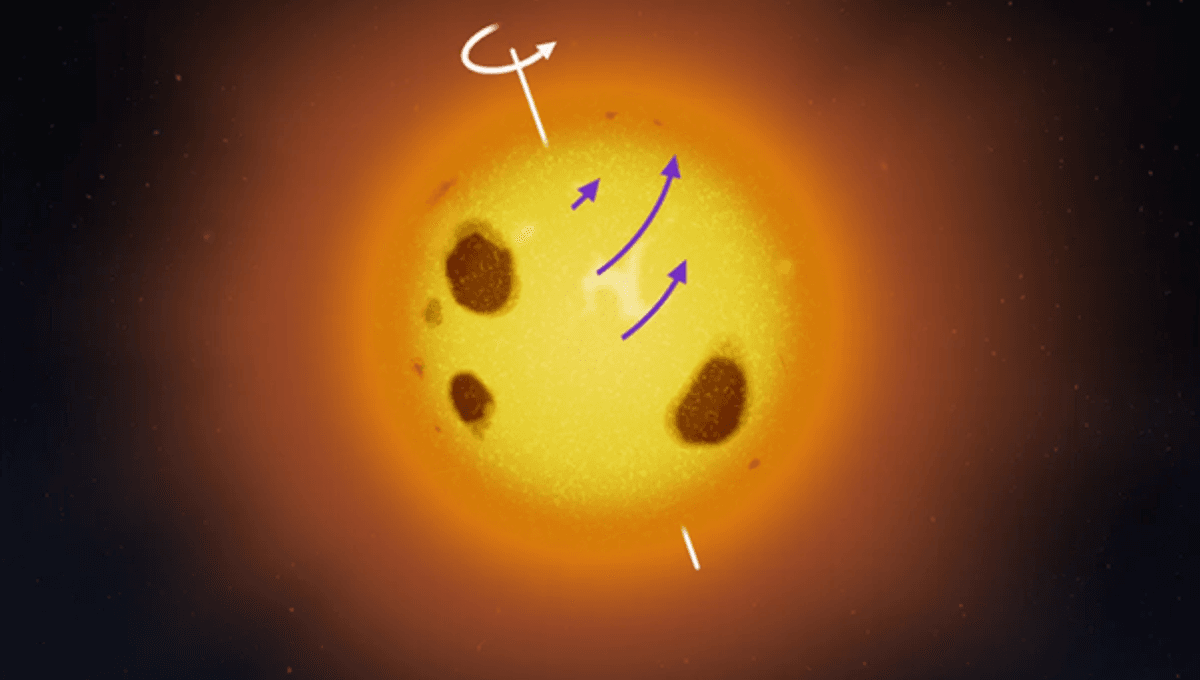
The star V889 Herculis rotates faster at midlatitudes than either the equator or the poles, unlike the Sun and everything we would expect. The astronomers who detected the pattern do not yet have an explanation, but when we find it there could be some big changes to our assumptions about stellar behavior.
Once astronomers started tracking the movements of sunspots, they realized the Sun rotated. That wasn’t so surprising, given that other astronomical bodies do too (even the Moon may appear not to until you think about it a little more). However, more detailed observations revealed that, unlike planets or moons, the Sun does not rotate at the same rate throughout. The equator takes about 25 Earth days to spin, while the figure for the poles is about 34 days, with intermediary values at mid-latitudes.
This is thought to be because hot plasma rises to the surface nearly parallel to the axis of rotation near the poles, but perpendicular at the equator. Conservation of angular moment forces faster rotation at the equator, and in a fluid body the forces between regions are insufficient to keep the rotations matched.
Even our most advanced telescopes lack the capacity to track starspots on other stars with the same precision. Nevertheless, we can see enough to know that some rotate much more quickly, and others more slowly. To the extent we could measure different rotation rates by latitude, it appeared they either shared the trait of rotating faster the closer one gets to the equator or had similar rotation at all latitudes.
These conclusions were reached based on relatively short-term observations of rotations, but the physics fits the observations, and all seemed well with the heavens, until we looked at V889 Herculis.
With mass and temperature just marginally greater than the Sun, but an age of 50 million years, V889 Herculis is considered one of the best proxies we have seen for the Sun at 1 percent of its current age. At 115 light years away it is hardly nearby, but still closer than 99.9 percent of the stars in the galaxy, making it a prime candidate for study.
Stars spin quickly when they are formed, and slow with age. In this, V889 Herculis is no exception – it rotates once every 32 hours, allowing astronomers to observe a great many rotations. Fourteen years ago, a study reported the expected result that the equator rotates faster than the poles, lapping them roughly every 150 days, but this ignored the mid-latitudes.
Given the gradual way the Sun slows down with latitude, that didn’t seem to be a problem, but a team led by Dr Mikko Tuomi of the University of Helsinki (best known for helping discover Proxima Centauri b) has complicated things. They found that the maximum rotation occurs at latitudes of 37-40 degrees. The equator turns slower, but the poles slowest of all.
“We applied a newly developed statistical technique to the data of a familiar star that has been studied at the University of Helsinki for years. We did not expect to see such anomalies in stellar rotation. The anomalies in the rotational profile of V889 Herculis indicate that our understanding of stellar dynamics and magnetic dynamos are insufficient,” Tuomi said in a statement.
The team used the same technique to explore the rotational profile of LQ Hydrae, a star 20 percent less massive than the Sun, and the same age as V889 Herculis. Its rotation could not be distinguished from a solid body, where the equator and poles turn at the same rate. However, the authors think its equator probably still rotates faster, just to such a small extent we lack the capacity to detect the difference.
Both V889 Herculis and LQ Hydrae have been tracked for 30 years by robotic telescopes at the Fairborn Observatory that are the size of large amateur instruments, rather than the giants that dominate professional astronomy. Such modest instruments cannot make out the individual starspots at this distance, but they make up for that with long-term observations tracking a rise and fall in brightness.
Tuomi and colleagues picked out curves they think are indicative of times when spots were predominantly located in one part of the star. With thousands of rotations taking place over the time each star was observed, this gave them a large sample to work on.
“It is amazing that even in the era of great space-based observatories we can obtain fundamental information on stellar astrophysics with small 40cm [16-inch] ground-based telescopes,” Tuomi said.
The study is published in Astronomy & Astrophysics.
Source Link: One Star’s Rotation Is Unlike Any Others’ And We Don’t Know Why